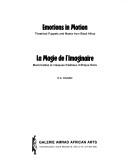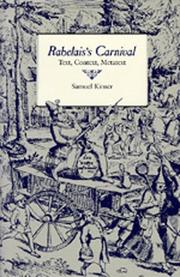| Listing 1 - 5 of 5 |
Sort by
|
Book
ISBN: 9782708990258 270899025X Year: 1990 Publisher: Toulouse: Privat,
Abstract | Keywords | Export | Availability | Bookmark
 Loading...
Loading...Choose an application
- Reference Manager
- EndNote
- RefWorks (Direct export to RefWorks)
La fête est la plus fugace des oeuvres collectives. Elle ne produit rien. Dans le dernier feu du carnaval, elle brûle ses propres traces, elle consume ses propres symboles. D'où la tentation de discourir à perte de vue sur ce vide, de le remplir de son propre désir. Ce livre essaie d'échapper à ce vertige. Ce moment où toute l'existence devient comme un théâtre, ce moment où chacun se montre en se déguisant, il fallait le donner à voir. Charles Camberoque, le photographe, et Daniel Fabre, l'ethnologue, ont regardé ensemble les mêmes fêtes dans les villes et villages du Languedoc et aussi d'Andorre et de Catalogne. Leurs visions se conjuguent. Chacune ouvrant ses propres perspectives, elles rendent à la fête une authenticité et une complexité surprenantes. Après sa première parution en 1977, ce livre a connu un destin inattendu. Dans les mascarades de rue, sur les planches du théâtre, sur les écrans de cinéma, il est venu étayer la renaissance multiple du carnaval. Cette deuxième édition, refondue et mise à jour, tient compte de cette aventure. Sans reprendre par le menu une histoire proche, elle pose un double regard sur la fête en ses élans nouveaux.

ISBN: 0969308159 Year: 1990 Publisher: Montréal Galerie Amrad African Arts
Abstract | Keywords | Export | Availability | Bookmark
 Loading...
Loading...Choose an application
- Reference Manager
- EndNote
- RefWorks (Direct export to RefWorks)
702.3 --- afrikaanse kunst --- cultuurgeschiedenis --- maskers --- poppen --- kunstgeschiedenis, primitieve volken --- Masks --- Puppets --- Puppets and puppet-plays --- Puppet theater --- Costume --- Carnival

ISBN: 0520065220 0585164568 Year: 1990 Volume: 10 Publisher: Berkeley, Calif. University of California Press
Abstract | Keywords | Export | Availability | Bookmark
 Loading...
Loading...Choose an application
- Reference Manager
- EndNote
- RefWorks (Direct export to RefWorks)
Rabelais, François --- Carnival in literature. --- Carnival in literature --- French Literature --- Romance Literatures --- Languages & Literatures --- Rabelais, François, --- 840 "15" RABELAIS, FRANCOIS --- Franse literatuur--?"15"--RABELAIS, FRANCOIS --- 840 "15" RABELAIS, FRANCOIS Franse literatuur--?"15"--RABELAIS, FRANCOIS --- Rable, Fransua --- Rabelais, François, --- Alcofribas, --- Alcofribas Nasier, --- Alcofrybas, --- Alcofrybas Nasier, --- Nasier, Alcofribas, --- Rabelais, Francis, --- Rabelais, Frants, --- Rabelais, Franz, --- Rable, Fransua, --- Rampelai, Phransoua, --- Рабле, Франсуа, --- ראבלע, פ. --- Рабле, Франсоа, --- Rable, Fransoa, --- Knowledge --- Manners and customs. --- Social life and customs. --- Rable, Pʻransua,
Book
ISBN: 0691067791 Year: 1990 Publisher: Princeton Princeton University Press
Abstract | Keywords | Export | Availability | Bookmark
 Loading...
Loading...Choose an application
- Reference Manager
- EndNote
- RefWorks (Direct export to RefWorks)
Chaucer, Geoffrey --- Knowledge --- Performing arts --- England --- Popular culture --- History --- Medieval period, 1066-1485 --- Popular culture in literature --- Chaucer, Geoffrey, d. 1400. Canterbury tales. --- Chaucer, Geoffrey, d. 1400 - Knowledge - Performing arts. --- England - Popular culture - History - Medieval period, 1066-1485. --- Performing arts - England - History. --- Performing arts in literature. --- Popular culture in literature. --- Carnival in literature.
Book
ISBN: 069122692X Year: 1990 Publisher: Princeton, N.J. : Princeton University Press,
Abstract | Keywords | Export | Availability | Bookmark
 Loading...
Loading...Choose an application
- Reference Manager
- EndNote
- RefWorks (Direct export to RefWorks)
Spanish villagers tell many folktales that describe in metaphorical language the struggles of young men and women as they emerge from their parental families and join in love. In this book James Taggart presents dozens of orally transmitted tales, including "Snow White," "Cinderella," "Beauty and the Beast," "Blancaflor," and dragonslayer stories, collected from seven villages in the region of CNBceres, and analyzes the differences in male and female approaches to telling them. His study shows how men and women use the tales to grapple with some of the contradictions found in gender relations in their culture, which conditions men to be sexually assertive and to marry virgins and which teaches women to fear the men who court them. Taggart interprets the male-female dialogue voiced through storytelling by linking the content of specific tales to the life experiences and gender of the storyteller. Men and women, he finds, carry out an exchange of ideas by retelling the same stories and altering the plots and characters to express their respective views of courtship. This indirect narrative dialogue conveys an understanding of the opposite sex and establishes a common model of marriage that permits men and women to overcome their fear of each other and bond in heterosexual love.
Sex role --- Courtship --- Folklore. --- Spain --- Marriage customs and rites --- Folklore --- Aarne-Thompson tale type. --- Ahigal. --- Arroyomolinos. --- Barrado. --- Barry, Herbert III. --- Bazagona. --- Becedas. --- Cabal, Constantino. --- Cabezuela. --- Christ. --- Cortés Vázquez, Luis. --- Cox, Marian Roalfe. --- Donjuanismo. --- Dundes, Alan. --- Falassi, Alessandro. --- García y Garcia, Segundo. --- Grimms, the (brothers). --- Herzfeld, Michael. --- Jaraíz de la Vera. --- Lewis, Oscar. --- Los Olivos. --- Virgin Mary. --- Zipes, Jack. --- agrarian working class symbols. --- agrotowns. --- beauty: symbolism of. --- bridal gift. --- cannibals. --- carnival. --- dance groups. --- defloration. --- disenchantment. --- eagle. --- enchantment. --- erotic aggression. --- family structure. --- feminism. --- filial piety. --- folklore. --- forest. --- gender segregation. --- helpful characters. --- idealization of women. --- incest. --- male competition. --- mass media. --- matrilocality. --- menstrual magic. --- thieves. --- ugliness. --- witchcraft.
| Listing 1 - 5 of 5 |
Sort by
|

 Search
Search Feedback
Feedback About UniCat
About UniCat  Help
Help News
News